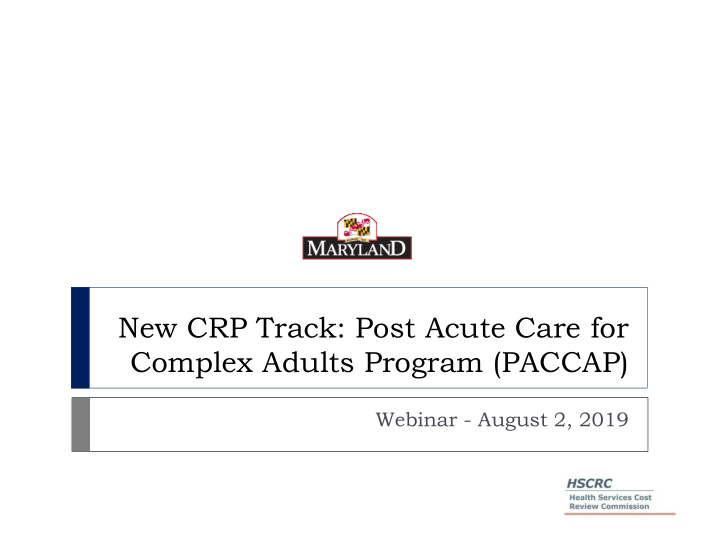



New CRP Track: Post Acute Care for Complex Adults Program (PACCAP) Webinar - August 2, 2019
Executive Overview PACCAP: New CRP track could start January 1, 2020 CRP tracks are convened by hospitals; participation is voluntary Hospital determines potential care partners and if/how to share resources PACCAP is designed to allow hospitals to share resources with Skilled Nursing Facilities (SNFs) and Home Health Agencies (HHAs) Hospital proposed concept under auspices of Secretary Neall’s workgroup on Hard to Place Patients PACCAP can help to address barriers to timely discharge, reduce avoidable utilization and facilitate care in more appropriate settings The cost of these interventions will come from the hospital’s GBR CRP calendar required State to submit draft Implementation Protocol to CMS by June 30 for consideration of January 2020 start Draft PACCAP Implementation Protocol submitted to CMMI June 28 Level of hospital interest will determine final recommendation 2
Executive Overview, cont. To the extent this flexibility is needed before some hospitals move forward with such hospital-PAC collaboration, we want to provide that flexibility using Medicare waivers under CRP Even if some hospitals currently do this, then getting credit and putting these activities on CMMI’s radar screen will provide evidence of collaboration As with other CRP tracks, could promote further opportunities and conversations around cross-continuum collaboration to improve quality and reduce costs, which is the true intent of the Maryland Model 3
Problem Patients with complex conditions or who need additional care supports for discharge to occur often remain in the hospital beyond when it is still medically necessary SNFs and HHAs do not accept these patients since it is uneconomical for them to provide care management staff or additional resources for these patients. This does not count as a readmission but is still an unnecessary hospitalization, since they could be treated in another setting. These untimely discharges can lead to extreme lengths of stay, potential quality detriments and deteriorating patient satisfaction This problem is particularly acute for beneficiaries with, e.g.,: Exacerbated dementia/delirium Bariatric conditions Advanced wound care needs 4
Purpose of PACCAP PACCAP will allow hospitals to share resources with SNFs/HHAs to facilitate complex patient discharge The Care Redesign Program includes waivers that would allow hospitals to share resources that would otherwise be prohibited by fraud and abuse laws Incentive payments and shared savings are not included in PACCAP PACCAP is not designed to address any other regulator issues for post-acute care providers or complex patients 5
Care Redesign Interventions Hospitals will choose which interventions to implement as part of their program under PACCAP Initially, PACCAP will focus on the Hospital-SNF/HHA relationship, but may expand to other post-acute care settings as appropriate The interventions may include: Deploying nurses and other care management supports in order to round with patients Creating clinical care pathways with the SNF/HHA staff Coordinating discharge planning and care management with hospital based care teams Provision of therapy services, as appropriate, in SNFs/HHAs Provision of resources, such as bariatric equipment, to SNFs 6
Intervention Resources The hospital may provide intervention resources to help the SNF/HHAs implement their care redesign interventions Intervention resources will take one of two forms: Nursing & support staff (FTEs) – Hospitals will provide clinical staff to the SNFs/HHAs to both help implement the clinical care model and create care coordination linkages Infrastructure support – Hospitals will provide physical resources to help implement their care pathways. For example, the hospital may provide a bed that is low to the ground for a patient identified as a fall risk Per CRP requirements, hospitals will be required to record the type of resources and the time that those resources are made available to the SNFs/HHAs 7
Design and Regulatory Details PACCAP would begin January 1, 2020 Existing CRP Fraud & Abuse waivers are adequate to allow sharing of resources (e.g., clinical staff, infrastructure) No additional waivers requested for CY 2020 No incentive payments for CY 2020 SNFs and Home Health Agencies (HHAs) are the only potential Care Partners for CY 2020 8
Request for Letters of Intent Hospitals that are interested in participating in PACCAP should submit a letter of intent to hscrc.care- transformation@maryland.gov no later than Friday, August 9 th , 2019 HSCRC will determine whether to proceed with the submission to CMMI based on the level of expressed interest in PACCAP 9
Questions for hospitals Are hospitals interested in providing resources to post-acute care providers in order to address complex patients’ needs? Can sitters currently be deployed to post-acute care providers? Do these partnerships already exist? Are the Fraud & Abuse laws the primary regulatory obstacle to forming effective partnerships with post-acute care providers? What other issues exist that prevent hospitals from partnering with post-acute care providers? Do those issues prevent effective partnerships regardless of the Fraud & Abuse laws? Would hospitals be interested in PACCAP if other regulatory flexibilities were provided? 10
Q&A and Open Discussion
Recommend
More recommend